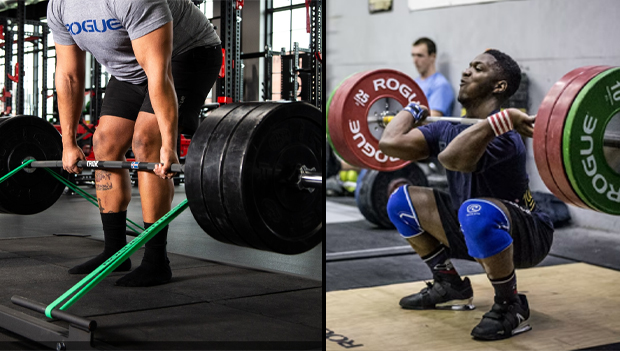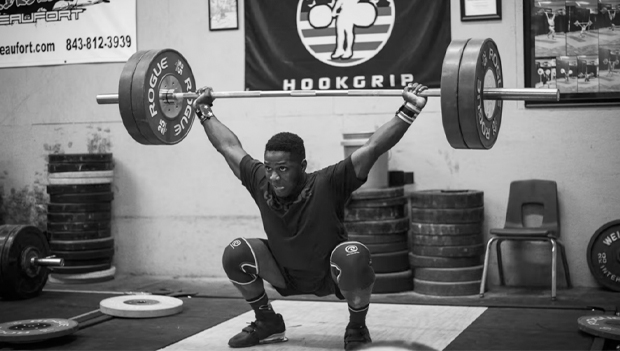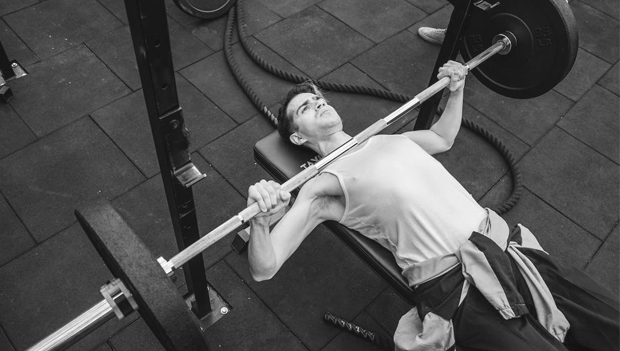
Barbells are a foundational piece of strength training equipment. If you're a beginner, they can feel intimidating, but they're worth getting to know. Barbells are extremely versatile—not only can you swap out weight plates to customize them to your needs, you can use them for a plethora of workouts from squats to deadlifts to bench presses.
But while they look pretty straightforward, all barbells aren't the same. They're made of different materials and have varying sleeve diameters, so they won't all work with the same weight plates. They also have different knurling patterns and varying levels of whip (how much the barbell will flex when loaded with weight). Of course, they range in price too, from budget barbells to splurge pieces.
We have a lot of personal experience with barbells so we’re here to help you get started. In this Olympic barbells versus standard barbells guide, we'll break down two of the most common types of barbells to help you determine which one is better for you.
Why Trust Us?
The health and safety of ACTIVE's readers is of the utmost importance to us. To ensure your well-being when consuming protein powders, the ACTIVE.com editorial team prioritizes products that are independently tested by a third-party. We've also consulted with a team of nutritionists and dieticians to ensure the products we feature are of the highest standard. This helps us create the most accurate, authentic review content for our readers. More importantly, fitness may be our job, but it is also our passion. Therefore, we strive to bring you products that we trust and would personally use.
Olympic Bar vs. Standard Bar Overview
By clicking on the product links in this article, we may receive a commission fee at no cost to you, the reader. Sponsorships and affiliate commissions help support our research so we can help you find the best products. Read the full affiliate disclosure here.
There are many types of barbells out there, but Olympic barbells and standard barbells are among the two most common. While standard bars are more versatile and often considered a “hybrid” bar, they're not meant for heavy weightlifting and certain compound movements. If you're new to barbell workouts, you can start with a standard bar but if you progress to Olympic lifts, getting a specialized Olympic bar is worth the upgrade. Here's everything you need to know about Olympic barbells vs. standard barbells.
Here are some of our favorites:
- REP Fitness Gladiator Olympic Barbell
- Titan Fitness Olympic Barbell
- REP Fitness Sabre Barbell
- Rogue Ohio Power Bar
- Force USA Ranger Barbell
- Rogue IWF Olympic Barbell
Olympic Bar

Olympic barbells are specifically designed for Olympic-style lifts like snatches and clean and jerks. One of the biggest things that sets an Olympic barbell apart is its spinning sleeves. These spinning sleeves allow the weight plate to rotate and stay balanced as you lift the bar. This reduces force and torque and helps you perform explosive movements more safely.
All Olympic bars are a standard weight and length (45 pounds and 7.2 feet for men's bars and 33 pounds and 6.5 feet for women's). They also have 2-inch sleeves that work with Olympic weight plates and can often hold up to 1,500 pounds. While some have knurling, they usually have a smooth center to prevent scraping during Olympic-style movements and weightlifting knurl marks. They also typically have more whip than standard bars—this gives the bar some momentum during Olympic lifts and compound movements.
SPECS
- Sizes: 7.2' (men's); 6.5' (women's)
- Common Materials: Steel
- Weights: 45 lbs. (men's); 33 lbs. (women's)
- Finishes: Bare steel, chrome, black oxide, zinc
What We Like About Olympic Bars
- Spinning sleeves
- Heavier duty than other bars
- Some whip for compound movements
What We Don't Like About Olympic Bars
- Usually more expensive
- Knurling can be too aggressive
Standard Bar

Standard bars are pretty basic. They're a straight, steel rod that's very rigid with little to no whip. They're typically five to seven feet long and can weigh up to 45 pounds, but may weigh less (it's common to see 25- and 35-pound standard bars too). They typically have moderately knurled sections near the sleeves and in the center, as well as dual knurl marks—both for powerlifting and weightlifting.
Standard barbells don't have spinning sleeves and are made to hold up to about 350 pounds (although you may be able to find some heavier-duty ones). They're 1 inch in diameter, so they can only be used with certain weight plates.
SPECS
- Sizes: 5, 6 and 7'
- Common Materials: Steel
- Weights: Up to 45 lbs.
- Finishes: Bare steel, black oxide, zinc
What We Like About Standard Bars
- Versatile
- Dual knurling marks for all types of lifts
- Less expensive than other types
What We Don't Like About Standard Bars
- Don't hold as much weight as other bars
- Can only work with standard plates
Olympic Bar vs Standard Bar: The Bottom Line
Differences
One of the major differences between an Olympic bar and a standard bar is the weight capacity. Many Olympic barbells can hold around 1,500 pounds, while standard barbells usually go up to about 350 pounds. To accommodate this heavier weight and reduce force during your lift, Olympic barbells also have spinning sleeves, while the sleeves on standard barbells are fixed.
Olympic barbells are thicker (two inches compared to one), heavier, and made of higher quality steel, but have some whip, while standard barbells are made of cheaper steel and are more rigid.
Similarities
Both types of barbells are made of steel—just different grades that can hold different weights. Some standard barbells weigh 45 pounds and measure 7 feet long, the same as an Olympic barbell. Both types of bars have knurling and knurl marks, although the degree and position may vary.
How to Pick a Barbell
Types of Barbell Finish
The type of barbell finish matters for two reasons: It affects the grip and the longevity of the bar. Barbells come in four main finishes: bare steel, chrome, black oxide, and zinc. Bare steel bars have the most aggressive knurling and can be easiest to grip, but they also rust more quickly than coated bars.
Chrome bars have less aggressive knurling so they're more prone to slipping, but they typically last longer since they're protected from rust. Zinc and black oxide bars last the longest, but they're often the most expensive.
Knurling
Knurling, which is a pattern of rough ridges on the bar, is also an important consideration. Knurling can be light to aggressive and helps you get a better grip on the bar. Aggressive knurling has the most grip but can be roughest on your hands. If you're lifting really heavy weights, you probably want to go with aggressive knurling, but if you're not, moderate will likely work for you.
Some bars have knurling on the sides and in the center, while others have a smooth center with knurled sides. The center knurling is beneficial for powerlifting moves like squats since it helps prevent the bar from slipping down your back. On the other hand, if you're a dedicated Olympic weightlifter, the center knurling can actually get in the way and make your lifts uncomfortable.
FAQs About Olympic vs. Standard Barbells
Are Olympic bars better?
Olympic bars aren't necessarily better; it really just depends on your needs. Because Olympic bars are heavier and can handle more weight, they're better for heavier lifting. They also have rotating sleeves, which helps reduce the amount of force felt during more explosive movements like power cleans.
Why is an Olympic bar 45 lbs.?
Olympic bars are made of heavier-duty steel and are longer and wider than standard barbells. They also have thicker sleeves. This intentional design allows them to hold heavier weights but also makes them heavier. All Olympic barbells come at a standard 45-pound weight.
What size is a standard barbell?
Standard barbells are usually five to seven feet long and weigh up to 45 pounds. They have a one-inch diameter that works with standard weight plates.


